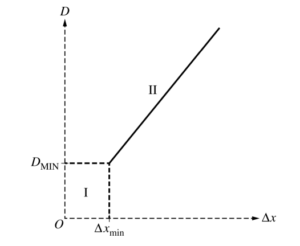Question

A block of mass m is placed on top of an ideal spring of spring constant k . The block is pushed against the spring, compressing the spring a distance ∆x. The block is released from rest, leaves the spring at the position shown in the figure, travels upward, and enters a track with a constant radius of curvature R that has negligible friction. The block enters the track at point A, maintains contact with the track, and exits horizontally at point B, a distance 3R above the point the block was released. The block then falls to the ground and lands a horizontal distance D from the end of the track. Express all algebraic answers in terms of m, k , , ∆x R, and physical constants, as appropriate. The size of the block is much smaller than the radius of curvature of the track.
(a) On the dot below, which represents the block, draw and label the forces (not components) that act on the block while still in contact with the track at point B. Each force must be represented by a distinct arrow starting on, and pointing away from, the dot.

Justify your choice of vectors.
(b)
i. Derive an expression for the speed v of the block at point B.
ii. Derive an expression for the magnitude of the net force F on the block at point B.
(c) Derive an expression for the minimum value of Δxmin required in order for the block to maintain contact with the track through point B. The procedure is repeated several times with the distance Δx > Δxmin.
(d) Calculate the distance D that the block travels.
(e) The graph below shows the best-fit line drawn by the students through their data of D as a function of Δx.

i. Explain why there are no data for section I of the graph.
ii. Explain the reason for the shape and minimum value of section II on the graph.
Answer/Explanation
Ans:
(a)

The force of gravity is includes because it always polls objects toward the earth (down). Depending on how fast the block is moving, it might also experience a normal force from the ramp. The normal force is always perpendicular to the surface, so it too points down
(b)
i.
E2 = E1
Kf + Uf = Usil
\(\frac{1}{2}mv^{2}+mgh = \frac{1}{2}ux^{2}\)
\(mv^{2}+2mg(3R)=k(\Delta x)^{2}\)
\(v = \sqrt{\frac{k(\Delta x^{2})-comgR}{m}}\)
ii.
\(F_{net}=\frac{mv^{2}}{R}\)
\(=\frac{m\left ( \frac{k(\Delta x)^{2}-6 mg R}{m} \right )}{R}\)
\(F = \frac{k(\Delta x)^{2}}{R}-6mg\)
(c)
\(F_{grav}=\frac{mv^{2}}{r}\)
\(mg=\frac{mv^{2}}{R}\)
\(v = \sqrt{gR}\)
\(\sqrt{gR}=\sqrt{\frac{k(\Delta x^{2})-6 mgR}{m}}\)
mgR = k(Δx)2 – 6mgR
7mgR = k(Δx)2
\(\Delta x_{min} = \sqrt{\frac{7mgR}{k}}\)
(d)
\(w/f_{f}=y_{1}+{v_{1}}^{t}+\frac{1}{2}at\)
\(0 = 3R – \frac{(g)}{2}t^{2}\)
\(\sqrt{\frac{6R}{g}}= t\)
xf = x1 + vt
D = v(t)
\(D = \sqrt{\frac{k(\Delta x)^{2}-6mgR}{m}}.\sqrt{\frac{6R}{g}}\)
\(D = \sqrt{\frac{6kR(\Delta x)^{2}-6mgR^{2}}{mg}}\)
(e)
i.
When Δx is less than Δxmin, the block does not maintain contact with the track until point B
ii.
D is directly proportional to the square root of (Δx)2, which means that D is proportional to Δx, this linear relationship produces a line.
Question

A block of mass m starts from rest at point A and travels with negligible friction through the loop onto a horizontal surface, where the block makes contact with a spring of spring constant \(k = \frac{mg}{2R}\) . All motion of the spring is in the horizontal direction. Point C is the highest point on the loop, and point B is the rightmost point on the loop. Express all algebraic answers in terms of m, h, R, and physical constants, as appropriate.
(a) On the dot below, which represents the block, draw an arrow that represents the direction of the acceleration of the block at point B in the figure above. The arrow must start on and point away from the dot.

Justify your answer.
(b)
i. Derive an expression for the speed v of the block at point B.
ii. Derive an expression for the magnitude of the net force F on the block at point B.
(c) In terms of R, derive an expression for the minimum height hmin necessary for the block to maintain contact with the track through point C.
(d) It is determined that h = 0.30 m and R = 0.10 m . If the block is released from a height greater than that found in part (c) , what would be the maximum compression xMAX of the spring?
(e) A graph of the maximum compression of the spring as a function of height is shown below. The height hmin is the height calculated in part (c) .

i. Explain why section I appears as a horizontal line segment on the horizontal axis.
ii. Explain the reason for the shape of section II on the graph.
Answer/Explanation
Ans:
(a)

The block is under the influence of two forces: gravity, which yields a downwards acceleration, & the normal force in the loop, yielding an acceleration to the left. The result and vector will be what is shown above.
(b)
i.
E1 = E2
\(mgh = mgR + \frac{1}{2}mr^{2}\rightarrow v^{2}= 2 (gh-gR)\rightarrow v=\sqrt{2g(h-R)}m/s\)
ii.
\(F_{net}= F_{gravity}+F_{centripetal}= mg + \frac{mv^{2}}{R}=mg+\frac{m}{R}(2g(h-R))\)
\(= F_{net}=\frac{2mgh}{R}=mg\) N. \(C_{1}= mg+\frac{2mgh}{R}-\frac{2mgR}{R}\)
(c)
\(a_{c}= g = \frac{v^{2}}{R}\rightarrow v_{min} = \sqrt{gR}\) \(\left ( \sqrt{gR} \right )^{2}=\left ( \sqrt{2(gh-2gR)} \right )^{2}\)
Ei = Ef gR = 2gh – 4 gR
\(mgh = mg(2R)+\frac{1}{2}mv^{2}\) G2gh = 5gR
\(v = \sqrt{2(gh-2gR)}\) \(G_{h} = \frac{5}{2}R\)
(d)
E2
\(mgh = \frac{1}{2}kx^{2}\rightarrow x_{max}= \sqrt{\frac{2mgh}{k}}=\sqrt{\frac{2mgh}{\left ( \frac{mg}{2R} \right )}}=\sqrt{4hR}=\sqrt{4(0.3)(0.1)}=0.3464 m.\)
(e)
i.
Since ac < g (a) point C, the cart will fall of the track, and will not reach the spring. IA follows there can be no spring compression.
ii.
as calculated in part (a), \(x_{max}=\sqrt{4hr},\therefore x_{max}\oe \sqrt{h}.\) The graph of section II follows the expected shape of a square – rood function.
